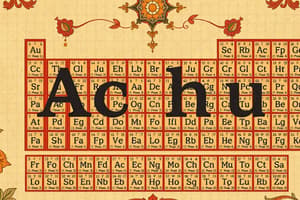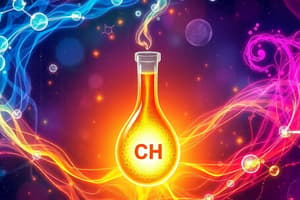Podcast
Questions and Answers
What are the negatively charged particles in an atom?
What are the negatively charged particles in an atom?
- Neutrons
- Protons
- Nuclei
- Electrons (correct)
Which group of the periodic table contains noble gases?
Which group of the periodic table contains noble gases?
- Group 18 (correct)
- Group 1
- Group 17
- Group 12
What type of bond is formed by the sharing of electrons?
What type of bond is formed by the sharing of electrons?
- Covalent Bonds (correct)
- Hydrogen Bonds
- Ionic Bonds
- Metallic Bonds
In a chemical reaction, what are the substances called that undergo change?
In a chemical reaction, what are the substances called that undergo change?
Which state of matter has a definite shape and volume?
Which state of matter has a definite shape and volume?
What is the pH range of a neutral solution?
What is the pH range of a neutral solution?
Which type of reaction involves the absorption of heat energy?
Which type of reaction involves the absorption of heat energy?
What is the term for the substance that dissolves in a solution?
What is the term for the substance that dissolves in a solution?
Flashcards are hidden until you start studying
Study Notes
Basic Concepts of Chemistry
- Matter: Anything that has mass and occupies space. Exists in solid, liquid, and gas states.
- Atoms: Basic unit of matter; made up of protons, neutrons, and electrons.
- Protons: Positively charged particles in the nucleus.
- Neutrons: Neutral particles in the nucleus.
- Electrons: Negatively charged particles orbiting the nucleus.
Periodic Table
- Organized by increasing atomic number.
- Groups: Vertical columns; elements share similar properties.
- Periods: Horizontal rows; indicate energy levels of electrons.
- Key Groups:
- Group 1: Alkali metals (e.g., Lithium, Sodium).
- Group 17: Halogens (e.g., Fluorine, Chlorine).
- Group 18: Noble gases (e.g., Helium, Neon).
Chemical Bonds
- Ionic Bonds: Formed by the transfer of electrons from one atom to another (e.g., NaCl).
- Covalent Bonds: Formed by the sharing of electrons (e.g., H2O).
- Metallic Bonds: Attraction between metal atoms and free electrons.
Chemical Reactions
- Reactants: Substances that undergo change.
- Products: Substances formed as a result of a reaction.
- Types of Reactions:
- Synthesis: A + B → AB
- Decomposition: AB → A + B
- Single Replacement: A + BC → AC + B
- Double Replacement: AB + CD → AD + CB
- Combustion: Hydrocarbon + O2 → CO2 + H2O
States of Matter
- Solid: Definite shape and volume; particles packed closely.
- Liquid: Definite volume but no definite shape; particles less tightly packed.
- Gas: No definite shape or volume; particles far apart and move freely.
Acids and Bases
- Acids: Substances that donate protons (H+) in a solution (e.g., HCl).
- Bases: Substances that accept protons or produce hydroxide ions (OH-) in a solution (e.g., NaOH).
- pH Scale: Measures acidity or alkalinity; ranges from 0 (acidic) to 14 (basic).
Thermodynamics
- Endothermic Reactions: Absorb energy (heat) from surroundings.
- Exothermic Reactions: Release energy (heat) to surroundings.
Stoichiometry
- Use of balanced chemical equations to calculate reactants and products.
- The mole concept: A mole equals 6.022 x 10^23 particles.
Solutions
- Solvent: Substance that dissolves the solute (e.g., water).
- Solute: Substance being dissolved (e.g., salt).
- Concentration: Amount of solute in a given volume of solution.
Organic Chemistry
- Study of carbon-containing compounds.
- Key functional groups include:
- Hydroxyl (-OH): Alcohols
- Carboxyl (-COOH): Carboxylic acids
- Amino (-NH2): Amino acids
Environmental Chemistry
- Study of chemical processes occurring in the environment.
- Focus on pollution, greenhouse gases, and chemical impact on ecosystems.
Basic Concepts of Chemistry
- Matter is defined as anything with mass that occupies space, existing in three states: solid, liquid, and gas.
- Atoms, the fundamental unit of matter, consist of protons (positively charged), neutrons (neutral), and electrons (negatively charged).
Periodic Table
- The periodic table is organized by increasing atomic number.
- Groups are vertical columns where elements possess similar chemical properties, while periods are horizontal rows indicating energy levels of electrons.
- Key Groups include:
- Alkali metals (Group 1): Examples include Lithium and Sodium.
- Halogens (Group 17): Examples include Fluorine and Chlorine.
- Noble gases (Group 18): Examples include Helium and Neon.
Chemical Bonds
- Ionic bonds occur through the transfer of electrons, exemplified by sodium chloride (NaCl).
- Covalent bonds form via electron sharing, as seen in water (H2O).
- Metallic bonds arise from the attraction between metal atoms and the sea of free electrons.
Chemical Reactions
- Reactants are the initial substances undergoing a transformation, while products are the new substances formed.
- Key reaction types include:
- Synthesis: A + B → AB
- Decomposition: AB → A + B
- Single Replacement: A + BC → AC + B
- Double Replacement: AB + CD → AD + CB
- Combustion: Hydrocarbon + O2 → CO2 + H2O
States of Matter
- Solids have a definite shape and volume due to closely packed particles.
- Liquids possess a definite volume with no fixed shape, allowing particles to be less tightly packed.
- Gases have no definite shape or volume, with particles widely spaced and moving freely.
Acids and Bases
- Acids are substances that release protons (H+) in solution, such as hydrochloric acid (HCl).
- Bases accept protons or produce hydroxide ions (OH-) in solution, exemplified by sodium hydroxide (NaOH).
- The pH scale quantifies acidity (0-14), where lower values indicate acidity and higher values indicate alkalinity.
Thermodynamics
- Endothermic reactions absorb energy (heat) from their environment.
- Exothermic reactions release energy (heat) into their surroundings.
Stoichiometry
- Stoichiometry utilizes balanced chemical equations to determine quantities of reactants and products.
- A mole, a fundamental concept, contains 6.022 x 10^23 particles, known as Avogadro's number.
Solutions
- A solvent is the medium that dissolves a solute (e.g., water), while the solute is the substance being dissolved (e.g., salt).
- Concentration measures the amount of solute present in a specified volume of solvent.
Organic Chemistry
- Organic chemistry focuses on carbon-based compounds.
- Key functional groups are significant in organic compounds:
- Hydroxyl group (-OH): Characteristic of alcohols.
- Carboxyl group (-COOH): Defines carboxylic acids.
- Amino group (-NH2): Essential to amino acids.
Environmental Chemistry
- Environmental chemistry examines chemical processes in the ecosystem.
- Key focus areas include pollution management, greenhouse gas effects, and the impact of chemicals on ecosystems.
Studying That Suits You
Use AI to generate personalized quizzes and flashcards to suit your learning preferences.




